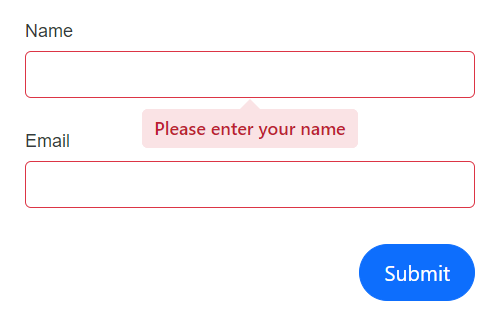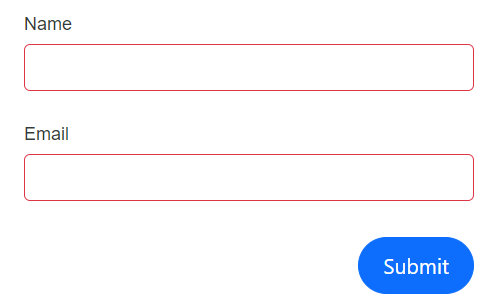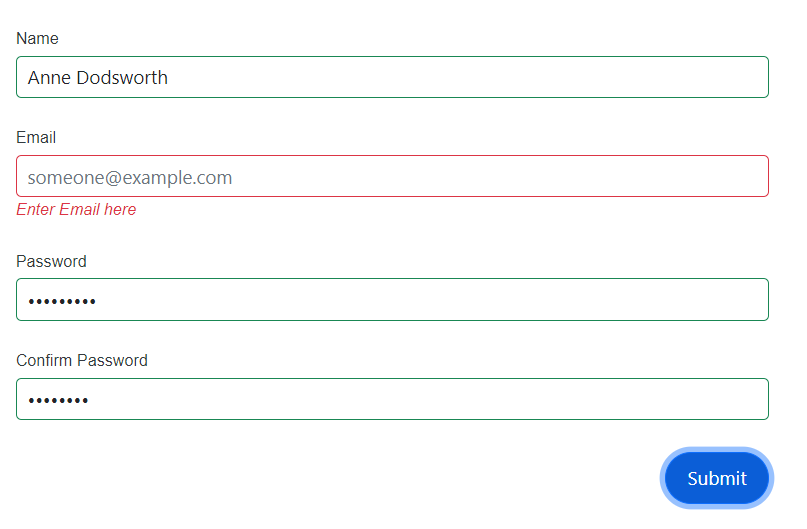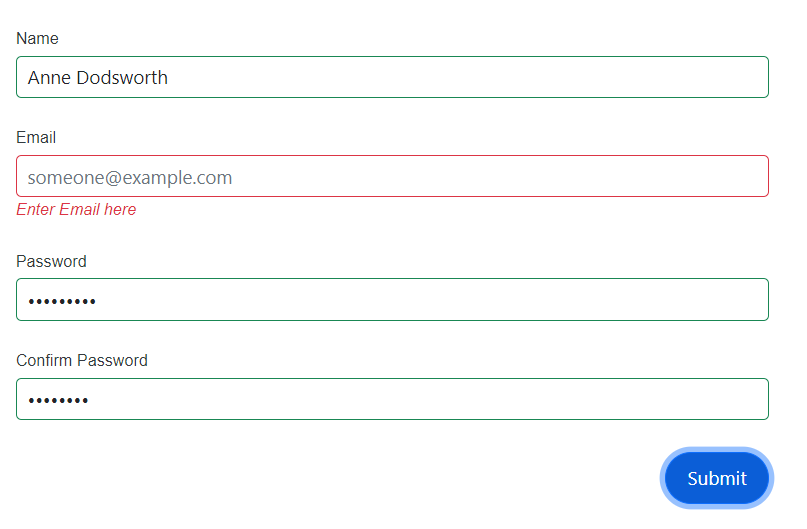Validation in DataForm component
4 Nov 202510 minutes to read
DataForm supports standard and custom validation compatible with theEditForm component. Such as DataAnnotationsValidator , ObjectGraphDataAnnotationsValidator etc…We can specify the required validation inside FormValidator RenderFragment of the DataForm component , The following examples illustrate the procedures for setting up the component with various validation.
Data annotations validation
DataAnnotationsValidator in the DataForm validates fields based on data annotation attributes applied to the model properties.
@using Syncfusion.Blazor
@using Syncfusion.Blazor.DataForm
@using Syncfusion.Blazor.Buttons
@using System.ComponentModel.DataAnnotations
@using Syncfusion.Blazor.Inputs
<SfDataForm ID="MyForm"
Model="@SignUpModel"
Width="50%"
ButtonsAlignment="FormButtonsAlignment.Right">
<FormValidator>
<DataAnnotationsValidator></DataAnnotationsValidator>
<ValidationSummary></ValidationSummary>
</FormValidator>
<FormItems>
<FormItem Field="@nameof(SignUpModel.FirstName)" LabelText="First Name"></FormItem>
<FormItem Field="@nameof(SignUpModel.LastName)" LabelText="Last Name"> </FormItem>
<FormItem Field="@nameof(SignUpModel.Email)" LabelText="Email Id"> </FormItem>
<FormItem Field="@nameof(SignUpModel.Password)" LabelText="Password" EditorType="FormEditorType.Password"> </FormItem>
<FormItem Field="@nameof(SignUpModel.ConfirmPassword)" LabelText="Confirm Password" EditorType="FormEditorType.Password"> </FormItem>
<FormItem Field="@nameof(SignUpModel.Accept)" LabelText="Agree to the terms and conditions"> </FormItem>
</FormItems>
<FormButtons>
<SfButton>SignUp</SfButton>
</FormButtons>
</SfDataForm>
@code {
public class SignUpDetails
{
[Required(ErrorMessage = "Please enter first name")]
public string FirstName { get; set; }
[Required(ErrorMessage = "Please enter last name")]
public string LastName { get; set; }
[Required(ErrorMessage = "Please enter password")]
public string Password { get; set; }
[Required(ErrorMessage = "Please enter confirm password")]
public string ConfirmPassword { get; set; }
[Required(ErrorMessage = "Please enter the email id")]
public string Email { get; set; }
[Required(ErrorMessage = "You need to agree to the Terms and Conditions")]
[Range(typeof(bool), "true", "true", ErrorMessage = "You need to agree to the Terms and Conditions")]
public bool Accept { get; set; }
}
private SignUpDetails SignUpModel = new SignUpDetails();
}
Validation message display
Validation messages can be displayed inline, via tooltip, or hidden by using ValidationDisplayMode. With inline display, messages are visible when validation occurs. Tooltip display reveals messages on hover/focus. None hides messages from the UI.
| FormValidationDisplay | Snapshot |
|---|---|
| FormValidationDisplay.Inline |  |
| FormValidationDisplay.Tooltip |  |
| FormValidationDisplay.None |  |
The following example demonstrates how to configure validation message presentation in the DataForm component.
@using Syncfusion.Blazor.DataForm
@using System.ComponentModel.DataAnnotations
<SfDataForm Width="50%"
Model="@RegistrationDetailsModel"
ValidationDisplayMode="FormValidationDisplay.Tooltip">
<FormValidator>
<DataAnnotationsValidator></DataAnnotationsValidator>
</FormValidator>
<FormItems>
<FormAutoGenerateItems></FormAutoGenerateItems>
</FormItems>
</SfDataForm>
@code {
public class RegistrationDetails
{
[Required(ErrorMessage = "Please enter your name")]
public string Name { get; set; }
[Required(ErrorMessage = "Please enter your email address")]
[EmailAddress(ErrorMessage = "Please enter valid email address")]
public string Email { get; set; }
}
private RegistrationDetails RegistrationDetailsModel = new RegistrationDetails();
}Complex model validation
The ObjectGraphDataAnnotationsValidator within the DataForm validates the entire object graph of the bound model, including collection and complex-type properties. In the following example, the ValidateComplexType attribute validates properties declared in nested classes such as ChildModel and GrandChildModel.
NOTE
Install the Microsoft.AspNetCore.Components.DataAnnotations.Validation NuGet package to enable complex model validation.
@using System.ComponentModel.DataAnnotations
@using Syncfusion.Blazor.DataForm
<div class="mt-4" style="margin: 0 auto;">
<SfDataForm Model="@MyModel" Width="50%">
<FormValidator>
<ObjectGraphDataAnnotationsValidator></ObjectGraphDataAnnotationsValidator>
</FormValidator>
<FormItems>
<FormItem Field="@nameof(MyModel.Name)" LabelText="Name"></FormItem>
<FormItem Field="@nameof(MyModel.Child.GrandChild.Email)" LabelText="Email" Placeholder="[email protected]"> </FormItem>
<FormItem Field="@nameof(MyModel.Child.GrandChild.Password)" EditorType="FormEditorType.Password" LabelText="Password"></FormItem>
<FormItem Field="@nameof(MyModel.Child.GrandChild.ConfirmPassword)" EditorType="FormEditorType.Password" LabelText="Confirm Password"></FormItem>
</FormItems>
</SfDataForm>
</div>
@code {
UserDetails MyModel { get; set; } = new UserDetails();
abstract class Credential
{
[Required(ErrorMessage = "Enter Password here")]
public string Password { get; set; }
[Required(ErrorMessage = "Enter Confirm Password here")]
public string ConfirmPassword { get; set; }
[Required(ErrorMessage = "Enter Email here")]
public string Email { get; set; }
}
class GrandChildModel : Credential
{
}
class ChildModel : Credential
{
[ValidateComplexType]
public GrandChildModel GrandChild { get; set; }
public ChildModel()
{
GrandChild = new GrandChildModel();
}
}
class UserDetails : Credential
{
public int Id { get; set; }
[Required(ErrorMessage = "Enter FirstName here")]
public string Name { get; set; }
[ValidateComplexType]
public ChildModel Child { get; set; }
public UserDetails()
{
Child = new ChildModel();
}
}
}
Fluent validation
FluentValidator is a custom validator that validates beyond standard data annotations. It supports rules such as credit card format checks, comparisons between fields, and range/threshold validations defined in FluentValidation rule classes.
NOTE
Install the Blazored.FluentValidation NuGet package to use Fluent validation with the DataForm.
@using Syncfusion.Blazor.DataForm
@using System.ComponentModel.DataAnnotations
@using Microsoft.AspNetCore.Components.Forms
@using Syncfusion.Blazor.Inputs
@using Syncfusion.Blazor.Buttons
@using Syncfusion.Blazor.Calendars;
@using FluentValidation
@using Blazored.FluentValidation
<SfDataForm ID="MyForm"
Model="@PaymentDetailsModel"
Width="50%">
<FormValidator>
<FluentValidationValidator Validator="PaymentDetailsValidation" />
</FormValidator>
<FormItems>
<FormItem Field="@nameof(PaymentDetailsModel.Name)" LabelText="Full Name on Card"></FormItem>
<FormItem Field="@nameof(PaymentDetailsModel.CardNumber)" LabelText="Card Number"></FormItem>
<FormItem Field="@nameof(PaymentDetailsModel.ExpirationDate)" LabelText="Expiration Date">
<Template>
<label class="e-form-label">Expiration Date</label>
<SfDatePicker EnableMask="true" Format="MM/yy" @bind-Value="@PaymentDetailsModel.ExpirationDate">
</SfDatePicker>
</Template>
</FormItem>
<FormItem Field="@nameof(PaymentDetailsModel.CVV)">
<Template>
<label class="e-form-label">CVV/CVC</label>
<SfMaskedTextBox Mask="000" PromptChar="@PromptCharacter" @bind-Value="@PaymentDetailsModel.CVV"></SfMaskedTextBox>
</Template>
</FormItem>
<FormItem Field="@nameof(PaymentDetailsModel.BillingAddress)" LabelText="Billing Address" EditorType="FormEditorType.TextArea">
</FormItem>
<FormItem Field="@nameof(PaymentDetailsModel.Accept)" EditorType="FormEditorType.Switch" LabelText="I agree to the terms and conditions"></FormItem>
</FormItems>
<FormButtons>
<SfButton>Pay</SfButton>
</FormButtons>
</SfDataForm>
@code {
char PromptCharacter { get; set; } = ' ';
public class PaymentDetails
{
[Required(ErrorMessage = "Enter Name on the card")]
public string Name { get; set; }
[Required(ErrorMessage = "Enter Billing Address")]
public string BillingAddress { get; set; }
[Required(ErrorMessage = "Enter Card number")]
public string CardNumber { get; set; }
[Required(ErrorMessage = "Enter Count here")]
public DateTime? ExpirationDate { get; set; }
[Required(ErrorMessage = "Enter CVV/CVC")]
public string CVV { get; set; }
[Required(ErrorMessage = "You need to agree to the Terms and Conditions")]
[Range(typeof(bool), "true", "true", ErrorMessage = "You need to agree to the Terms and Conditions")]
public bool Accept { get; set; }
}
private PaymentDetails PaymentDetailsModel = new PaymentDetails();
PaymentDetailsValidator PaymentDetailsValidation = new PaymentDetailsValidator();
}